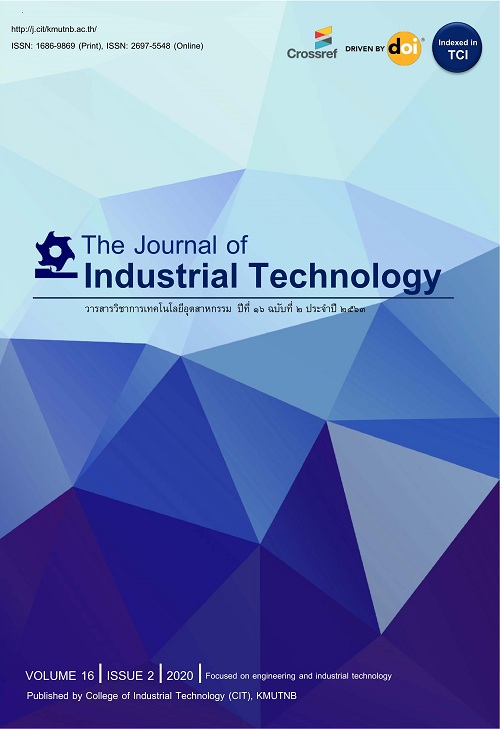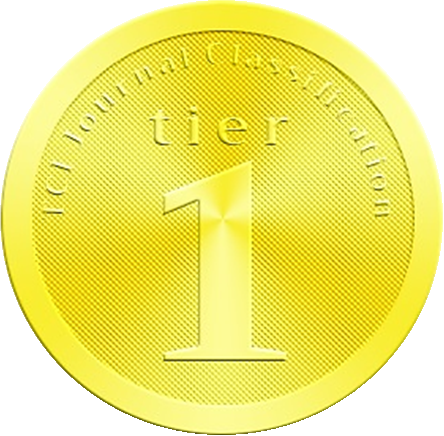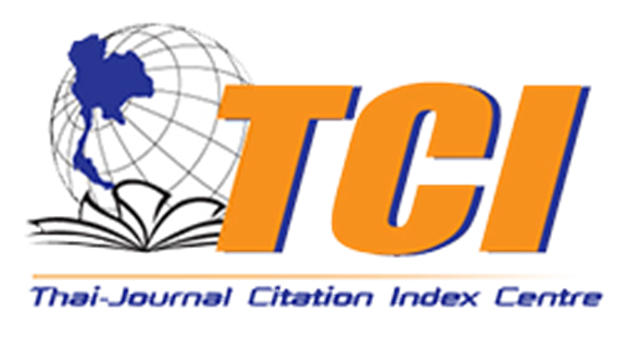Effect of Crystalline Waterproofing Material on Porosity and Water Absorption in Mortar
ผลของสารก่อผลึกต่อความพรุนและการดูดซึมน้ำในมอร์ต้าร์
Abstract
งานวิจัยนี้ศึกษาผลของการใช้สารก่อผลึก (CWPM) ทั้งชนิดสารผสมเพิ่ม (CM) และเคลือบผิว (CC) ในการลดความพรุนและการดูดซึมน้ำในมอร์ต้าร์ เพื่อพิจารณาการใช้ CWPM อย่างเหมาะสมจึงกำหนดอัตราส่วนน้ำต่อซีเมนต์ (W/C) ที่ 0.3 0.4 และ 0.6 การทดสอบ ได้แก่ ความพรุน การดูดซึมน้ำ และกำลังรับแรงอัด รวมถึงการตรวจสอบสารประกอบทางเคมีในตัวอย่างเพื่อยืนยันผลของ CWPM โดยปริมาณและวิธีการใช้ CWPM ปฏิบัติตามคำแนะนำของผู้ผลิต การทดสอบที่อายุ 40 วัน และหลังจากบ่มต่อในน้ำอีก 30 วัน ผลการศึกษาแสดงว่า CWPM ทั้งชนิด CM และ CC มีผลต่อความพรุนและการดูดซึมน้ำที่ลดลงอย่างมีนัยสำคัญ แต่มีผลแตกต่างกันตาม W/C และชนิดของ CWPM โดย W/C ที่ต่ำในตัวอย่างที่ผสม CWPM ให้ผลการลดความพรุนและการดูดซึมน้ำที่ดีกว่ารวมถึงผลของกำลังรับแรงอัดที่เพิ่มขึ้น ส่วนผลการวิเคราะห์สารประกอบทางเคมีพบว่าตัวอย่าง CWPM แสดงค่า Peak ของ CaCO3 และ Ettringite (AFt) โดยเฉพาะอย่างยิ่งของ Calcium Aluminate Silicate Hydrates; C-A-S-H) ปรากฏเด่นชัดมากกว่าตัวอย่างควบคุม ผลการทดสอบสนับสนุนการปรับปรุงลักษณะเฉพาะให้ดีขึ้นทั้งในการบ่มระยะสั้นและยาว และยังส่งผลดียิ่งต่อสมบัติด้านความทึบน้ำและอัตราการดูดซึมของตัวอย่างโดยเฉพาะเมื่อใช้ CWPM ชนิดผสมเพิ่มกับส่วนผสมที่มีค่า W/C ต่ำ (0.3) แต่การใช้ CWPM ชนิดเคลือบผิวกับส่วนผสมที่มี W/C ปานกลางถึงสูง (0.4-0.6) ให้ผลดีที่ชัดเจนกว่าส่วนผสมที่มีค่า W/C ต่ำ
This research investigates the effect of crystalline waterproofing material (CWPM), namely mixing type (CM) and coating type (CC), on reducing porosity and water absorption in mortar. To determine the optimum use of CWPM in the mortar, tests were conducted at water-to-cement (W/C) ratios of 0.3, 0.4, and 0.6. Tests included porosity, water absorption and finally compressive strength, as well as investigating the chemical compounds in the samples to confirm the effects of using CWPM. The amount and applied method of CWPM as the manufacturer's suggestion were used to produce mortar samples, after 40 days all set was wet cured for 30 days before test. The results showed that CWPM both types of significantly reduced porosity and the consequent water absorption, but differently. The W/C and type dependent were clear. The lower W/C and mixing type yielded better porosity, water absorption and compressive strength, compared to the control samples. Both cementitious CWPM type samples showed the more pronounced peaks of CaCO3 and Ettringite (AFt), especially calcium aluminate silicate hydrate (C-A-S-H), more clearly than the control samples. These results support the enhanced characteristics in both short-term and long-term curing, particularly by improving water resistance and reducing absorption rates. Specifically, the use of mixing-type CWPM with low to moderate W/C ratios (0.3 to 0.4) showed superior results, while coating-type CWPM was more effective with high W/C ratios (0.6) compared to lower W/C ratios.
Keywords
[1] D. Ribeiro, A. Sales, C. Sousa, F. Almeida, M. Cunha, M. Lourenço, and P. Helene, Corrosion in concrete structures: Theory, control and analysis methods, 1st Ed., Rio de Janeiro, Brazil, 2014.
[2] Subcommittee on concrete and materials, Durability of Concrete, Engineering Institute of Thailand under His Majesty the King’s Patronage (EIT), 2000. (in Thai)
[3] EN 1990, Eurocode-Basis of structural design, Brussels, 2002.
[4] E. P. Kearsley, and P. J. Wainwright, Porosity and permeability of foamed concrete, Cement and Concrete Research, 2001, 31(5), 805-812.
[5] A.M. Neville, Properties of concrete, Longman, London, 1995.
[6] B. Kerkhoff, Effects of substances on concrete and guide to protective treatments: Portland cement association, IL, 2007.
[7] A.A. Almusallam, F.M. Khan, S.U. Dulaijan, and O.S.B. Al-Amoudi, Effectiveness of surface coatings in improving concrete durability, Cement and Concrete Composites, 2003, 25(4), 473-481.
[8] M. Safiuddin, Concrete damage in field conditions and protective sealer and coating systems, Coatings, 2017, 7(7), 90.
[9] ACI 212.3R-10, Report on Chemical Admixtures, American Concrete Institute, MI, 2010.
[10] BS EN 934-2:2009, Admixtures For Concrete, Mortar and Grout-Part 2: Concrete Admixtures; Definitions, Requirements, Conformity, Marking and Labelling, British Standards Institution, London, 2009.
[11] V.G. Cappellesso, N. dos Santos Petry, D. C.C. Dal Molin, and A.B. Masuero, Use of crystalline waterproofing to reduce capillary porosity in concrete, Building Pathology and Rehabilitation, 2016, 1, 9.
[12] D. Yodmalai, R. Sahamitmongkol and S. Tangtermsirikul, The use of crystalline materials to improve the durability of concrete, TCA e-magazine, 2010, 9. (in Thai)
[13] S. Lim, and S. Kawashima, Mechanisms underlying crystalline waterproofing through microstructural and phase characterization, Journal of Materials in Civil Engineering, 2019, 31(9), 04019175.
[14] N. Khomwan, S. Sujjavanich and T. Kheaw-on, Effect of crystalline waterproofing materials on corrosion potential of steel in concrete, Innovative Infrastructure Solutions, 2024, 9, 12.
[15] M.J. Al‐Kheetan, M.M. Rahman, and D.A. Chamberlain, Development of hydrophobic concrete by adding dua-crystalline admixture at mixing stage, Structural Concrete, 2018, 19(5), 1504-1511.
[16] M.M. Rahman and D.A. Chamberlain, Application of crystallising hydrophobic mineral and curing agent to fresh concrete, Construction and Building Materials, 2016, 127, 945-949.
[17] M.M. Rahman and D.A. Chamberlain, Performance of crystalline hydrophobic in wet concrete protection, Journal of Materials in Civil Engineering, 2017, 29(6), 0401700.
[18] M.J. Al-Kheetan, M.M. Rahman and D.A. Chamberlain, Optimum mix design for internally integrated concrete with crystallizing protective material, Journal of Materials in Civil Engineering, 2019, 31(7), 04019101.
[19] ASTM C109/C109M-20 ASTM, Standard Test Method for Compressive Strength of Hydraulic Cement Mortars (Using 2-in. or [50 mm] Cube Specimens), ASTM International, PA, 2002.
[20] ASTM C642-97, Standard Test Method for Density, Absorption, and Voids in Hardened Concrete, ASTM International, PA 1997.
[21] RILEM Test No. II.4, Systems and Structures, Water Absorption Under Low Pressure (Pipe Method), European organization, Paris 1980.
[22] Z. D. Rong, W. Sun, H. J. Xiao and W. Wang, Effect of silica fume and fly ash on hydration and microstructure evolution of cement based composites at low water-binder ratios, Construction and Building Materials, 2014, 51, 446-450.
[23] I. Soroka, C.H. Jaegermann and A. Bentur, Short-term steam-curing and concrete later-age strength, Matériaux et Construction, 1978, 11( 2), 93-96.
[24] T. Kheaw-on, N. Khomwan and S. Sujjavanich, The effect of crystalline waterproofing materials on accelerated corrosion of steel reinforcement in concrete, International Journal of Civil Engineering, 2021, 19, 699–716.
[25] T.L. Weng and A. Cheng, Influence of curing environment on concrete with crystalline admixture, Monatshefte für Chemie - Chemical Monthly, 2014, 145(1), 195-200.
[26] D. Yodmalai, Durability properties of concrete with crystalline materials, Thesis, Thammasat University, 2011.
[27] T. Kheaw-on, N. Khomwan and S. Sujjavanich, The effect of crystalline coatings defects of steel-corrosion in reinforced concrete, Journal of Thailand Concrete Association, 2018, 6, (2), 49-57.
[28] P. Azarsa, R. Gupta and A. Biparva, Inventive microstructural and durability investigation of cementitious composites involving crystalline waterproofing admixtures and portland limestone cement, Materials, 2020, 13(6), 1425.
[29] B.-B Xiong, L. Gao, J.-G. Chen, X.-C. Lu, B. Tian, B.-F. Chen, and Y.-B. Li, Action mechanism for improving water impermeability of concrete surface based on deep penetrating sealer, Construction and Building Materials, 2022, 322, 126424.
[30] A. Gojević, V. Ducman, I.N. Grubeša, A. Baričević and I.B. Pečur, The effect of crystalline waterproofing admixtures on the self-Healing and permeability of concrete, 2021, Materials, 14(8), 1860.
[31] L.W. Teng, R. Huang, J. Chen, A. Cheng, and H.M. Hsu, A study of crystalline mechanism of penetration sealer materials, Materials, 2014, 7(1), 399-412.
[32] Y. Zhang, Q. Wang, J. Chen, J. Tang, H. Zhou, W. Zhou, X. Chang and Y. Cheng, Preparation and performance study of active chemicals in cementitious capillary crystalline waterproofing materials, Case Studies in Construction Materials, 2024, 20, e02874.
[33] G. Li, X. Huang, J. Lin, X. Jiang and X. Zhang, Activated chemicals of cementitious capillary crystalline waterproofing materials and their self-healing behaviour, Construction and Building Materials, 2019, 200, 36-45.
[34] Y. Zhang, L. Zuo, J. Yang, X. Cai, Y. Zhao and X. Zeng, Effect of cementitious capillary crystalline waterproofing coating on the gas permeability of mortar, Structural Concrete, 2019, 20(5), 1763-1770.
DOI: 10.14416/j.ind.tech.2025.04.004
Refbacks
- There are currently no refbacks.






